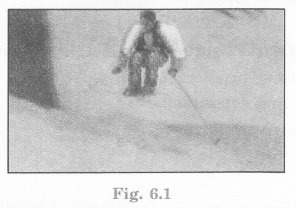NCERT Solutions for Class-6 Geography Chapter-6 Major Landforms of the Earth
NCERT TEXTBOOK EXERCISES
(a) What are the major landforms?
(b) What is the difference between a mountain and a plateau?
(c) What are the different types of mountains?
(d) How are mountains useful to man?
(e) How are plains formed?
(f) Why are the river plains thickly populated?
(g) Why are mountains thinly populated?
Answer:
(a) The surface of the earth is not the same everywhere. It has an infinite variety of landforms. The major landforms are,
1. Mountains
2. Hills
3. Plateaus
4. Basins
5. Plains
6. Peninsula
7. Islands, etc.
(b) Difference between a Mountain and a Plateau:
| Mountain | Plateau |
| (i) A mountain is a naturally elevated surface with a small summit and a broad base. | (i) A plateau is elevated flatlands. It is often called tableland because of flat surface. |
| (ii) It is considerably higher than the surrounding area. Height of a mountain is more than 900 metres. | (ii) It is less higher than the mountains with one or more sides having steep slopes. Its height varies from a few hundred metres to several thousand metres. |
| (iii) It consists of a series of ranges extending over hundreds of kilometers. | (iii) It may consist of some series. |
| (iv) Mountains vary in their heights and shapes because of their formation and age. | (iv) Plateaus vary in age. |
| (v) Mountains are mainly of two types: young and old mountains. | (v) Plateaus are of several types-intermontane piedmonts, old, new etc. |
| (vi) the Himalayas, Alps, Rockies and Andes are young while Atlas, Ural, Aravalli etc. are old mountains. | (vi) Deccan plateau of India, Brazil, Africa and Australia are old plateaus while Tibet plateau is new plateau with height varying from 4000-6000 metres, above mean sea level. |
1. Fold Mountains
2. Block Mountains
3. Volcanic Mountains
(d) Mountains are useful to man in the following ways:
1. They are storehouses of water.
2. They provide water to rivers through glaciers which they have
(a) Reservoirs are made and water is harnessed for the use of people.
(b) Water from mountains is used in irrigation.
(c) It is also used in the generation of hydroelectricity.
3. River valleys and river terraces are ideal for agriculture.
4. Mountains have a rich variety of flora and fauna,
(a) Forests provide fuel, fodder, shelter.
(b) They provide several other products.
5. Mountains provide idyllic sites for tourists.
6. They are important sites for several special games and sports like paragliding, hang gliding, river rafting and skiing at Kullu Manali, Shimla, Dharmashala, Dehradun.
(e) Formation of Plains:
Rivers and their tributaries bring silt and deposit it in low lying areas and form plains.
1. Rivers flow down mountain slopes and erode them.
2. They carry them forward.
3. They deposit their load of stones, sand and silt along their courses and in their valleys.
4. These deposits turn into plains.
(f) River plains are thickly populated because of the following reasons:
1. Plains are fertile. Agriculture is the main occupation of the people. It can sustain a large population easily.
2. Means of transport are easy to be constructed.
3. Ideal for human habitation due to flat land.
(g) Generally, the plains are flat and made up of fertile soil. So, they provide favorable conditions for agriculture. In plains, rivers flow slowly. Therefore, it can be used for navigation. The construction of the transport network is easy in flat areas. Due to these qualities, the river plains are thickly populated.
Question 2. Tick the correct answers.
(a) The mountains differ from the hills in terms of
(i) elevation
(ii) slope
(iii) aspect
(b) Glaciers are found in
(i) The Mountains
(ii) The Plains
(iii) The Plateaus
(c) The Deccan Plateau is located in
(i) Kenya
(ii) Australia
(iii) India
(d) The river Yangtze flows in
(i) South America
(ii) Australia
(iii) China
(e) An important mountain range of Europe is
(i) the Andes
(ii) the Alps
(iii) the Rockies
Answer:
(a) → (i) elevation
(b) → (i) The Mountains
(c) → (iii) India
(d) → (iii) China
(e) → (ii) the Alps
1 .A ………… is an unbroken flat or a low-level land.
2. The Himalayas and the Alps are examples of ………… types of mountains.
3. ………….. areas are rich in mineral deposits.
4. The ……….. is a line of mountains.
5. The ……….. areas are most productive for farming.
Answer:
1. Plain
2. Fold
3. Plateau
4. Range
5. Plains.
INTEXT QUESTIONS
Answer: Please see the map.
Examples of some more such landforms are:
1. Deccan Plateau
2. Black Forest
3. East African Plateau
4. Narmada and Tapi Valleys.
Answer: Yes, they are,
1. Shimla
2. Dehradun
3. Dharmashala
4. Kullu Manali.
Question 3. Can you name this game in the given figure?
Answer: The name of this game is skiing.
Answer:
Use of land in the following ways,
1. Agriculture
2. Pastoral activities
3. Mining
4. Habitation
5. Industries
6. Urbanisation
Use of water in the following ways,
1. Drinking
2. Domestic use
3. Fishing
4. Transportation
5. Industries
6. Sewage disposal
7. Irrigation
8. Generation of hydroelectricity
9. Urbanization
10. Domestic animals in rural areas like drinking, bathing, etc.

0 comment
Post a Comment